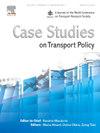Key factors affecting transportation choices in school commuting in Lisbon – A machine learning approach
IF 3.3
Q3 TRANSPORTATION
引用次数: 0
Abstract
Understanding the behaviour of students in choosing a transportation mode to school is crucial to promote Active Commuting to School (ACS) and the adoption of healthier lifestyles. Therefore, analysing all types of transportation modes with multiple factors/features is essential, though it can be a challenge in statistical modelling. The main objective of the present study was to determine the factors that contribute to the choice of a particular mode in school transportation, by using Machine Learning (ML) algorithms: Extreme Gradient Boosting (XGB), Random Forest (RF), Decision Tree (DT) and Multinomial Logistic Regression (MNL). Data from the ‘Hands Up’ Survey in Lisbon, Portugal, between 2018 and 2021, with 10 different modes of transportation were analysed. A range of factors including safety around school, socioeconomic status of schools’ parishes, school regime, school grades and the proximity of schools to the different public transportation modes were considered. The algorithms have been compared in terms of accuracy scores. The XGB algorithm shows the best performance (64 % accuracy and 0.33 Macro F1) for multi-class classification, while RT, DT and MNL provide accuracy of 40 %, 37 % and 47 % respectively. Weighted Average Feature Importance (WAFI) have been determined for all variables. For the best-performing algorithm, the XGB, the combination factor of school regime and school grade is the most relevant factor, contributing to around 21.2 % for multi-class classification. WAFI scores for each variable suggest that the proximity of schools to various public transports is an important factor contributing more than 50 % for the predominance of private car in school transportation.
影响里斯本学校通勤交通选择的关键因素——一种机器学习方法
了解学生在选择上学交通方式时的行为,对于促进主动通勤上学和采用更健康的生活方式至关重要。因此,分析具有多种因素/特征的所有类型的运输模式是必不可少的,尽管这在统计建模中可能是一个挑战。本研究的主要目的是通过使用机器学习(ML)算法:极端梯度增强(XGB)、随机森林(RF)、决策树(DT)和多项逻辑回归(MNL),确定影响学校交通特定模式选择的因素。该研究分析了2018年至2021年间在葡萄牙里斯本进行的“举手”调查的数据,其中包括10种不同的交通方式。考虑了一系列因素,包括学校周围的安全,学校教区的社会经济地位,学校制度,学校成绩以及学校与不同公共交通方式的接近程度。这些算法在准确率得分方面进行了比较。对于多类分类,XGB算法的准确率为64%,Macro F1为0.33,而RT、DT和MNL算法的准确率分别为40%、37%和47%。加权平均特征重要性(WAFI)已确定所有变量。对于表现最好的算法XGB,学校制度和学校年级的组合因素是最相关的因素,对多类别分类的贡献率约为21.2%。每个变量的WAFI分数表明,学校靠近各种公共交通工具是一个重要因素,对私家车在学校交通中占主导地位的贡献超过50%。
本文章由计算机程序翻译,如有差异,请以英文原文为准。
求助全文
约1分钟内获得全文
求助全文

 求助内容:
求助内容: 应助结果提醒方式:
应助结果提醒方式:


